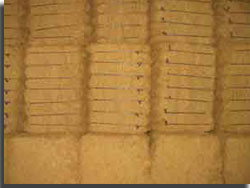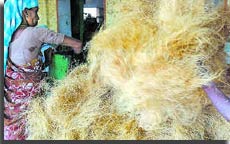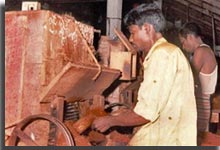| Size of the INDUSTRY | Total world coir fibre production is 250,000 tonnes. Today India, mainly the coastal region of Kerala State, produces 60% of the total world supply of white coir fibre. |
| Geographical distribution | Kerala, Tamil Nadu, Andhra Pradesh, Karnataka, Maharashtra, Goa, Odisha, Assam, Andaman & Nicobar, Lakshadweed, Pondicherry |
| Percentage in world market | India, mainly the coastal region of Kerala State, produces 60% of the total world supply of white coir fibre. |
| Market Capitalization | Kerala is the home of Indian coir industry where white fibre, accounting for 61 % of coconut production and over 85 % of coir products |

In India coir making is largely a dissipated industry with households producing miniscule quantity of products. They hady established an appeal of fibre by retting and then beating coconut for the interior husks. In India produced fibre and many as 1,402 of the 1,831 coir units in yarn hardly bothered about the advantages Kerala where in Alleppey, establishing the of professionally organising their traditional coastal town as the unchallenged headquarter of coir-making capabilities.
The golden textured Indian coir fibre, which Andhra Pradesh, Odisha and Goa produced captured the European and world markets. From then on, there was the success of Indian coir's reign and it had no turning back. The big corporates soon established coir factories in Alleppey, Kollam, Kozhikode, Kochi and other parts of Kerala. Industrial giants including Volkart Brothers, William Goodacre, Pierce Leslie and Aspinwall moved in to tap the potential offered by the golden fibre, and Alleppey was soon a household name all over Europe and India. By 1967 the "Golden Fibre" had captured the European and the world markets. Today the Coir Goe-Textiles or coir Bhoovastra has shot into the lime light which are mainly due to its eco-frinedly characteristics. They are being usually effectively used for improving soil bahaviours, preventing soil erosion, and in helping consolidation of soil. Coir is a 100% organic and bio-degradable fibre which has great water absorbency and has a definite edge over synthetic goe textiles, in the environmental aspect and issues. The greatest advantage of Coir is that it provides an ecological niche for rapid establishment of vegetation.
Coir being the geo-textiles come in a mind-boggling range of woven and non-woven varieties available for bio-engineering,including geo meshes,girds, geo-beds, anti-weed blankets, needled felts, erosion control blankets, geo-rolls, geo-webs, and fascines. The main reasons that helped the establishment of the coir spinning industry in Kerala are the presence of brackish backwaters and lagoons of the state. Brackish waters had to be replenished by fresh water at frequent intervals to wash away the water contaminated in the process of retting of husks, and Kerala was naturally endowed with this facility. This made an essential establishment of the the industry so firmly in India and particularly in kerala, even though coconut production was significantly high in several other countries like Indonesia, Philippines, SriLanka and Thailand. Indian coir industry is keeping pace with the change in technology and imbibing the latest developments in production techniques and designs.

At present, coir and its products are exported to more than 80 countries and the US is the single largest market with a share of more than 40% in the total export. European countries together share more than 41 % of the exports. Not only that the Coir Board have also participated in 11 international trade fairs and exhibitions during 2005-06 and displayed the range of products available for exports from India. Coir Board in India is a statutory body established by the Government of India under a legislation enacted by the Parliament namely, Coir Industry Act 1953 for the promotion and development of Coir Industry in India as a whole.

- Indian coir industry has a phenomenal share of 89% of the global market for value-added coir products. The export has increased from Rs.250 crore in 1997 to Rs.314 crore during 2000-01. Equally significant is the fact that most of these people are from the economically disadvantaged classes and 80% of the workers are women.
- The minimum export price (MEP) appears set to be scrapped as coir makers and exporters get geared up to face competition of the WTO and global markets. The Indian coir industry, that many thought was breathing its last in the early Nineties, is waking up to a new dawn and moving ahead with success which can be called as the great Indian rope trick.
- Recently, the Export Market Development Assistance Scheme of the Board had been modified to encourage more small exporters of Coir with an export turnover of less than Rs 2 crore to undertake promotional measures like participation in exhibition, study tour, buyer seller meet, etc.
- Even with a view to encouraging the sale of coir and coir products through the outlets of co-operative societies and the PSU's, the Coir Board has been granting Market Development Assistance (MDA). During 2005-06, an amount of Rs 170 lakh was disbursed by way of central share of MDA to various state governments.
 Recent Press Release
Recent Press Release
 INDIAN coir industry AT A Glance IN 2021 - 2022
INDIAN coir industry AT A Glance IN 2021 - 2022
 INDIAN coir industry AT A Glance IN 2020 - 2021
INDIAN coir industry AT A Glance IN 2020 - 2021
 INDIAN coir industry AT A Glance IN 2017 - 2018
INDIAN coir industry AT A Glance IN 2017 - 2018
 INDIAN coir industry AT A Glance IN 2016 - 2017
INDIAN coir industry AT A Glance IN 2016 - 2017
 INDIAN coir industry AT A Glance IN 2015 - 2016
INDIAN coir industry AT A Glance IN 2015 - 2016
 INDIAN coir industry AT A Glance IN 2014 - 2015
INDIAN coir industry AT A Glance IN 2014 - 2015
 INDIAN coir industry AT A Glance IN 2013 - 2014
INDIAN coir industry AT A Glance IN 2013 - 2014
 INDIAN coir industry AT A Glance IN 2012 - 2013
INDIAN coir industry AT A Glance IN 2012 - 2013
 INDIAN coir industry AT A Glance IN 2011 - 2012
INDIAN coir industry AT A Glance IN 2011 - 2012
 Federation of Indian Coir Exporters Associations [FICEA]
Federation of Indian Coir Exporters Associations [FICEA]
Indian Industries


